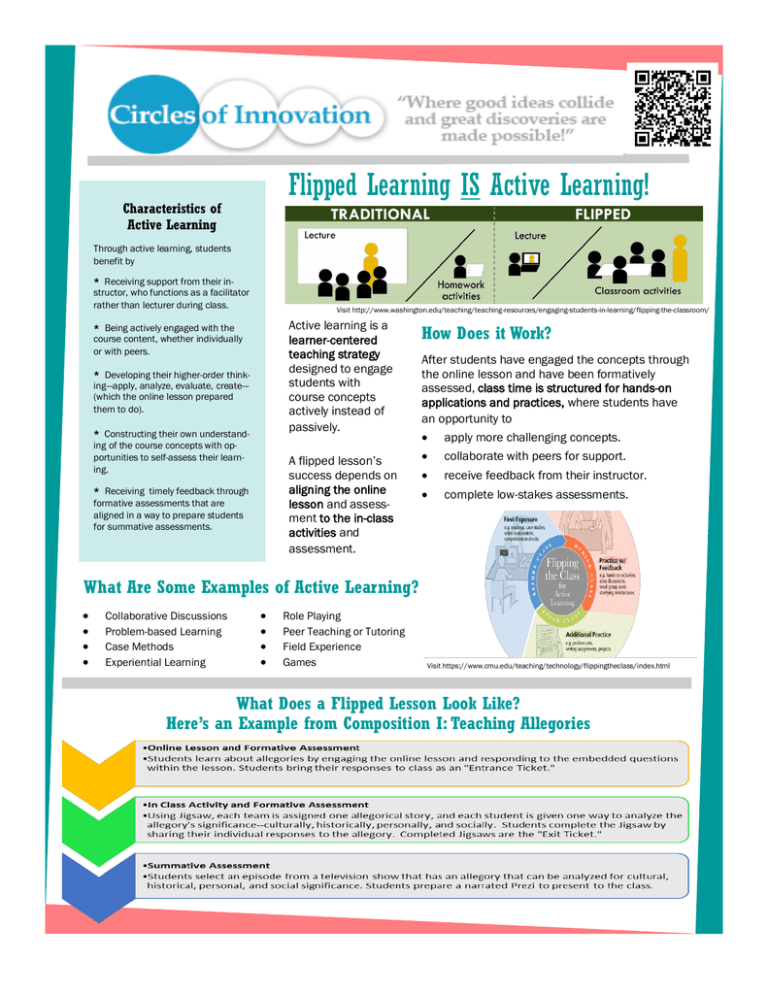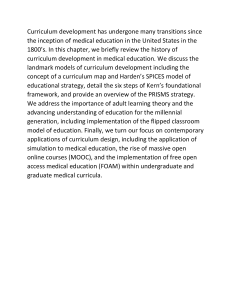Impact of Active Learning
advertisement

Flipped Learning IS Active Learning! Characteristics of Active Learning Through active learning, students benefit by * Receiving support from their instructor, who functions as a facilitator rather than lecturer during class. Visit http://www.washington.edu/teaching/teaching-resources/engaging-students-in-learning/flipping-the-classroom/ * Being actively engaged with the course content, whether individually or with peers. * Developing their higher-order thinking—apply, analyze, evaluate, create— (which the online lesson prepared them to do). * Constructing their own understanding of the course concepts with opportunities to self-assess their learning. * Receiving timely feedback through formative assessments that are aligned in a way to prepare students for summative assessments. Active learning is a learner-centered teaching strategy designed to engage students with course concepts actively instead of passively. How Does it Work? A flipped lesson’s success depends on aligning the online lesson and assessment to the in-class activities and assessment. collaborate with peers for support. receive feedback from their instructor. complete low-stakes assessments. After students have engaged the concepts through the online lesson and have been formatively assessed, class time is structured for hands-on applications and practices, where students have an opportunity to apply more challenging concepts. What Are Some Examples of Active Learning? Collaborative Discussions Problem-based Learning Case Methods Experiential Learning Role Playing Peer Teaching or Tutoring Field Experience Games Visit https://www.cmu.edu/teaching/technology/flippingtheclass/index.html What Does a Flipped Lesson Look Like? Here’s an Example from Composition I: Teaching Allegories Examples of Active Learning Strategies Collaborative Discussions Shared Viewpoints is when paired or teamed students discuss a concept or experience, looking for similarities in their approach or viewpoint; another approach is Opposing Viewpoints. Students are grouped in four: two students take one position on a topic while the other two students take the opposing view. Problem-based Learning Students are given an ill-structured problem or scenario. They work together to find solutions to the problem and consider the implications behind the problem and/or its results. Case Methods Teams of students are given different case studies on a concept or topic; in their team, they read their assigned case study, answer the questions, and briefly present the case to the class. Students are then quizzed on all of the presented case studies. From Linda Nilson’s Teaching at Its Best Dramatization Using Dramatization, have groups of students act out a concept under discussion; for example, when reading about the theme isolation, ask students to perform a scene that demonstrates this theme. Role Playing In Role Playing, students act out instructor-assigned roles, improvising the script, in response to realistic scenarios. To be effective, instructor needs to establish the context and setting for the role-playing. Using Hypothetical Scenarios Using inquiry-based learning, pose a hypothetical scenario related to a course concept where students, individually or in teams, work through the scenario to answer “what if?” From Nilson’s Teaching at Its Best Field Research Students, individually or in teams, conduct interviews, collect data, or take field notes on specific observations and then use this for a discussion, project, etc. Serial Testimony Serial Testimony offers each student an equal opportunity to reflect on the question being asked of them in a small group. It is an opportunity to hear other perspectives about a topic. The purpose is not to “piggyback” off others’ comments or to take sides but rather to contribute one’s own perspective or experience without interruption. http://www.tolerance.org/meaningfuldiscussions Cooperative-Collaborative Strategies Roundtable Students generate as many responses as they can to a prompt or question. To set this up, instructor poses the prompt/ question. Each group determines the order, and using one paper and one pen, the first student writes a response, while saying it out loud, and then passes the paper to the next person, who repeats the process. This continues until time is called. Jigsaw Group Projects Each teammate is asked to complete some discrete part of an assignment. When every member has completed his or her assigned task, the pieces can be joined together to form a finished project. http://www.ryerson.ca/content/dam/lt/ resources/handouts/activelearning.pdf Paired or Teamed Annotations Students read an article while taking notes. Then, students with the same article are paired or teamed together. In their group, they discuss the main ideas, looking for divergent and convergent thinking. Students submit a composite annotation that summarizes the group’s ideas on the article. Drill-Review Pairs Four students are grouped together as two pairs. Each pair is given two problems/questions to solve. Students are assigned the role of the explainer (gives step-by-step instructions on how to do the problem) and an accuracy checker (verifies correctness of methodology used to solve the problem). After the first problem/question is completed, students switch roles for the second problem. After both are complete, the pairs re-group and explain their problems and solutions with each other until a consensus is reached. http://www.ryerson.ca/content/dam/lt/resources/handouts/activelearning.pdf Active Learning: What’s the Buzz? —“The Flipped Classroom: An Opportunity to Engage Millennial Students through Active Learning Strategies” The article highlights “the flipped classroom as an opportunity to engage millennial students using active learning strategies [. . . .] in order to free class time from lecture [. . . . ] Using class time for active learning provides opportunities for greater teacher-to-student mentoring and peer-to-peer collaboration.”
